Beyond Global Trends: Two Decades of Climate Data in the World’s Highest Equatorial City
Abstract
1. Introduction
2. Materials and Methods
2.1. Study Site
2.2. Data Acquisition and Analysis
3. Results and Discussion
3.1. Temperature Trends in Quito over 2004–2024
3.2. Precipitation Trends in Quito over 2004–2024
3.3. El Niño Southern Oscillation Influence on Quito’s Temperature and Precipitation
3.4. Synthesis
4. Conclusions
Author Contributions
Funding
Institutional Review Board Statement
Informed Consent Statement
Data Availability Statement
Acknowledgments
Conflicts of Interest
Appendix A
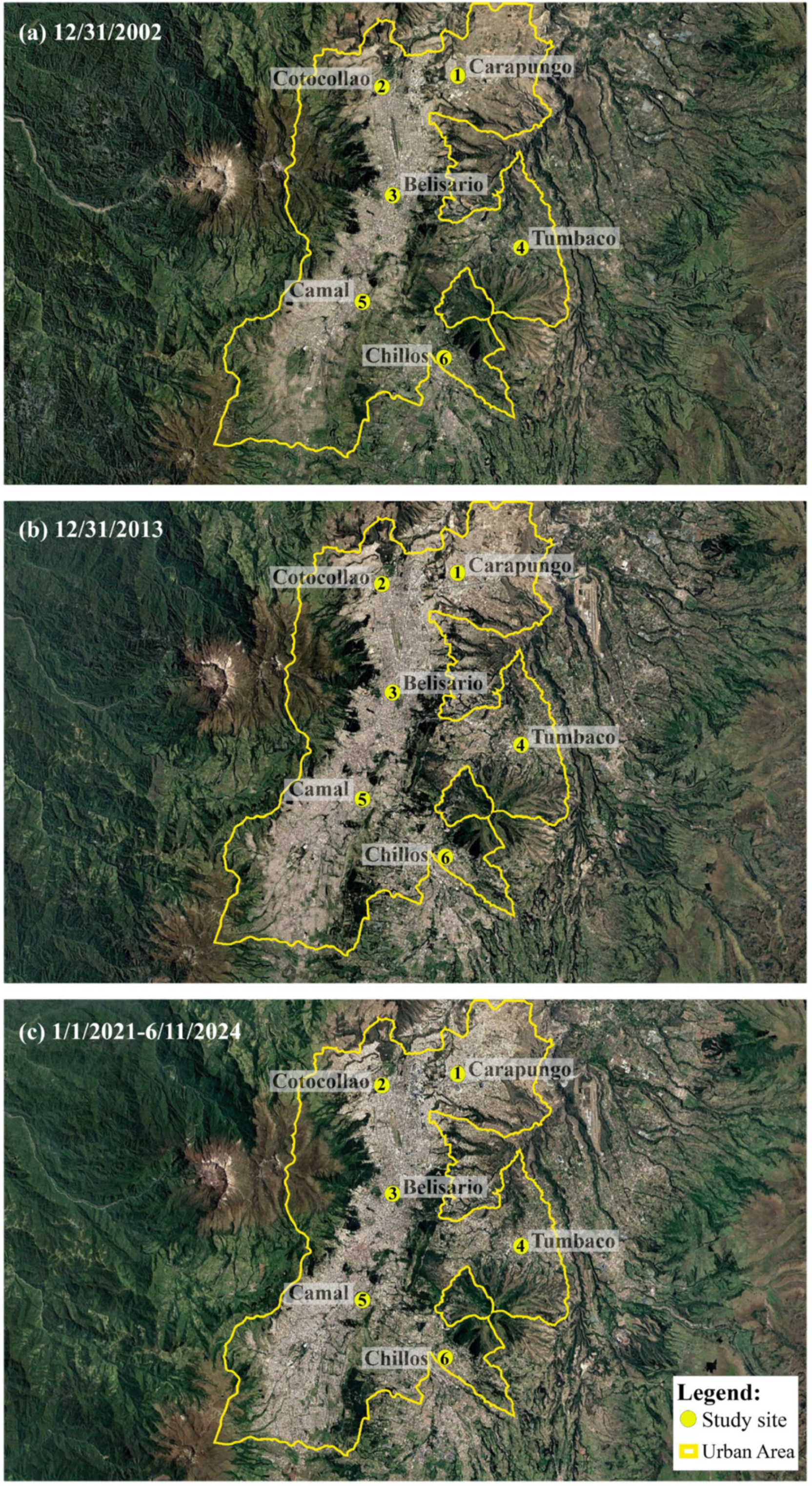

References
- Sachs, J.; Kroll, C.; Lafortune, G.; Fuller, G.; Woelm, F. The Decade of Action for the Sustainable Development Goals: Sustainable Development Report 2021; Cambridge University Press: Cambridge, UK, 2021. [Google Scholar]
- Intergovernmental Panel for Climate Change. Climate Change 2021: The Physical Science Basis. Contribution of Working Group I to the Sixth Assessment Report of the Intergovernmental Panel on Climate Change; Cambridge University Press: Cambridge, UK, 2021. [Google Scholar]
- WMO Climate Change: A Threat to Human Wellbeing and Health of the Planet. 2022. Available online: https://wmo.int/media/news/climate-change-threat-human-wellbeing-and-health-of-planet (accessed on 4 February 2025).
- United Nations Day of 8 Billion. Available online: https://www.un.org/en/dayof8billion (accessed on 4 February 2025).
- United Nations. Population Division World Population Prospects 2022: Summary of Results | Population Division. Available online: https://www.un.org/development/desa/pd/content/World-Population-Prospects-2022 (accessed on 16 July 2025).
- National Oceanic & Atmospheric Administration (NOAA). Mauna Loa Observatory: Carbon Cycle Greenhouse Gases. Trends in CO2, CH4, N2O, SF6. Available online: https://gml.noaa.gov/ccgg/trends/ (accessed on 2 July 2025).
- NASA Global Temperature. Available online: https://climate.nasa.gov/vital-signs/global-temperature/?intent=121 (accessed on 4 February 2025).
- Intergovernmental Panel on Climate Change (IPCC). Weather and Climate Extreme Events in a Changing Climate. In Climate Change 2021—The Physical Science Basis: Working Group I Contribution to the Sixth Assessment Report of the Intergovernmental Panel on Climate Change; IPCC, Ed.; Cambridge University Press: Cambridge, UK, 2021; pp. 1513–1766. ISBN 9781009157889. [Google Scholar]
- NASA-Goddard Space Flight Center. Temperatures Rising: NASA Confirms 2024 Warmest Year on Record—NASA. Available online: https://www.nasa.gov/news-release/temperatures-rising-nasa-confirms-2024-warmest-year-on-record/ (accessed on 16 July 2025).
- Climate Change Information for Regional Impact and for Risk Assessment. In Climate Change 2021—The Physical Science Basis: Working Group I Contribution to the Sixth Assessment Report of the Intergovernmental Panel on Climate Change; IPCC, Ed.; Cambridge University Press: Cambridge, UK, 2021; pp. 1767–1926. ISBN 9781009157889.
- United Nations Country Profiles. Available online: https://population.un.org/wup/countryprofiles?country=Ecuador (accessed on 2 July 2025).
- Intergovernmental Panel on Climate Change (IPCC). Central and South America; IPCC, Ed.; Cambridge University Press: Cambridge, UK, 2023. [Google Scholar]
- Zalakeviciute, R.; Lopez-Villada, J.; Ochoa, A.; Moreno, V.; Byun, A.; Proaño, E.; Mejía, D.; Bonilla-Bedoya, S.; Rybarczyk, Y.; Vallejo, F. Urban Air Pollution in the Global South: A Never-Ending Crisis? Atmosphere 2025, 16, 487. [Google Scholar] [CrossRef]
- Marin, A.; Möhle, E.; Aneise, A.J. Environmental Crisis and Sustainable Development in South America. In Oxford Research Encyclopedia of Climate Science; Oxford University Press: Oxford, UK, 2025. [Google Scholar]
- Vanacker, V.; Armando, M.; Rossana, T.; Edison, C.; Cadilhac, L. Challenges for Research on Global Change in Mainland Ecuador. Neotrop. Biodivers. 2018, 4, 114–118. [Google Scholar] [CrossRef]
- Tapia-Armijos, M.F.; Homeier, J.; Espinosa, C.I.; Leuschner, C.; de la Cruz, M. Deforestation and Forest Fragmentation in South Ecuador since the 1970s—Losing a Hotspot of Biodiversity. PLoS ONE 2015, 10, e0133701. [Google Scholar] [CrossRef] [PubMed]
- Sun, Q.; Zhang, X.; Zwiers, F.; Westra, S.; Alexander, L. V A Global, Continental, and Regional Analysis of Changes in Extreme Precipitation. J. Clim. 2021, 34, 243–258. [Google Scholar] [CrossRef]
- Dunn, R.J.H.; Alexander, L.V.; Donat, M.G.; Zhang, X.; Bador, M.; Herold, N.; Lippmann, T.; Allan, R.; Aguilar, E.; Barry, A.A.; et al. Development of an Updated Global Land In Situ-Based Data Set of Temperature and Precipitation Extremes: HadEX3. J. Geophys. Res. Atmos. 2020, 125, e2019JD032263. [Google Scholar] [CrossRef]
- Vuille, M.; Francou, B.; Wagnon, P.; Juen, I.; Kaser, G.; Mark, B.G.; Bradley, R.S. Climate Change and Tropical Andean Glaciers: Past, Present and Future. Earth-Sci. Rev. 2008, 89, 79–96. [Google Scholar] [CrossRef]
- Vuille, M.; Bradley, R.S.; Werner, M.; Keimig, F. 20th Century Climate Change in the Tropical Andes: Observations and Model Results. Clim. Change 2003, 59, 75–99. [Google Scholar] [CrossRef]
- Hock, R.; Rasul, G.; Adler, C.; Cáceres, B.; Gruber, S.; Hirabayashi, Y.; Jackson, M.; Kääb, A.; Kang, S.; Kutuzov, S.; et al. High Mountain Areas. In IPCC Special Report on the Ocean and Cryosphere in a Changing Climate; Cambridge University Press: Cambridge, UK; New York, NY, USA, 2019. [Google Scholar]
- Reyer, C.P.O.; Adams, S.; Albrecht, T.; Baarsch, F.; Boit, A.; Canales Trujillo, N.; Cartsburg, M.; Coumou, D.; Eden, A.; Fernandes, E.; et al. Climate Change Impacts in Latin America and the Caribbean and Their Implications for Development. Reg. Environ. Change 2017, 17, 1601–1621. [Google Scholar] [CrossRef]
- Almazroui, M.; Ashfaq, M.; Islam, M.N.; Rashid, I.U.; Kamil, S.; Abid, M.A.; O’Brien, E.; Ismail, M.; Reboita, M.S.; Sörensson, A.A.; et al. Assessment of CMIP6 Performance and Projected Temperature and Precipitation Changes Over South America. Earth Syst. Environ. 2021, 5, 155–183. [Google Scholar] [CrossRef]
- World Meteorological Organization. State of the Climate in Latin America and the Caribbean 2024; WMO: Geneva, Switzerland, 2025. [Google Scholar]
- Instituto Nacional de Estadística y Censos (INEC). Boletín técnico N° 01-2021-IPT-IH-IR: Índice de Puestos de Trabajo (IPT), Índice de Horas Trabajadas (IH) e Índice de Remuneraciones (IR); Dirección de Estadísticas Económicas (DECON), Gestión de Indicadores Económicos (GIE), Sistema de Indicadores de la Producción (SIPRO): Quito, Ecuador, 2021; Available online: https://www.ecuadorencifras.gob.ec/ (accessed on 5 May 2025).
- Rybarczyk, Y.; Zalakeviciute, R.; Ereminaite, M.; Costa-Stolz, I. Causal Effect of PM2.5 on the Urban Heat Island. Front. Big Data 2025, 8, 1546223. [Google Scholar] [CrossRef]
- Sietsma, A.J.; Ford, J.D.; Callaghan, M.W.; Minx, J.C. Progress in Climate Change Adaptation Research. Environ. Res. Lett. 2021, 16, 054038. [Google Scholar] [CrossRef]
- Harvey, C.A.; Saborio-Rodríguez, M.; Martinez-Rodríguez, M.R.; Viguera, B.; Chain-Guadarrama, A.; Vignola, R.; Alpizar, F. Climate Change Impacts and Adaptation among Smallholder Farmers in Central America. Agric. Food Secur. 2018, 7, 57. [Google Scholar] [CrossRef]
- EMASEO. Municipio del Distrito Metropolitano de Quito: Plan de Desarrollo 2012–2022; EMASEO: Quito, Ecuador, 2011. [Google Scholar]
- MECN. Ecosistemas del Distrito Metropolitano de Quito (DMQ); Publicación Miscelánea No. 6; MECN: Quito, Ecuador, 2009. [Google Scholar]
- INEC. Ecuador Crecio En 2.5 Millones de Personas Entre 2010 y 2022. Available online: https://www.censoecuador.gob.ec/ecuador-crecio-en-2-5-millones-de-personas-entre-2010-y-2022/ (accessed on 6 January 2024).
- Zalakeviciute, R.; López-Villada, J.; Rybarczyk, Y. Contrasted Effects of Relative Humidity and Precipitation on Urban PM2.5 Pollution in High Elevation Urban Areas. Sustainability 2018, 10, 2064. [Google Scholar] [CrossRef]
- Zambrano-Barragán, C.; Zevallos, O.; Villacís, M.; Enríquez, D. Quito’s Climate Change Strategy: A Response to Climate Change in the Metropolitan District of Quito, Ecuador BT—Resilient Cities; Otto-Zimmermann, K., Ed.; Springer: Dordrecht, The Netherlands, 2011; pp. 515–529. [Google Scholar]
- Serrano Vincenti, S.; Zuleta, D.; Moscoso, V.; Jácome, P.; Palacios, E.; Villacís, M. Análisis estadístico de datos meteorológicos mensuales y diarios para la determinación de variabilidad climática y cambio climático en el Distrito Metropolitano de Quito. LA GRANJA. Rev. Cienc. Vida 2012, 16, 23–47. Available online: https://www.redalyc.org/pdf/4760/476047400004.pdf (accessed on 4 February 2025). [CrossRef]
- Parra, R.; Cadena, E.; Flores, C. Maximum UV Index Records (2010–2014) in Quito (Ecuador) and Its Trend Inferred from Remote Sensing Data (1979–2018). Atmosphere 2019, 10, 787. [Google Scholar] [CrossRef]
- Vallejo, F.; Yanez, D. Air Ecuador 2025. Available online: https://zenodo.org/records/15503706 (accessed on 5 May 2025).
- Carslaw, D.C.; Ropkins, K. Openair—An R Package for Air Quality Data Analysis. Environ. Model. Softw. 2012, 27–28, 52–61. [Google Scholar] [CrossRef]
- Lümkemann, N.; Klimenta, M.; Hoffmann, M.; Meinen, J.; Stawarczyk, B. Dimensional Stability and Reproducibility of Varying FFF Models for Aligners in Comparison to Plaster Models. Materials 2023, 16, 4835. [Google Scholar] [CrossRef]
- Hyndman, R.J.; Khandakar, Y. Automatic Time Series Forecasting: The Forecast Package for R. J. Stat. Softw. 2008, 27, 1–22. [Google Scholar] [CrossRef]
- Wickham, H. Ggplot2: Elegant Graphics for Data Analysis; Springer: New York, NY, USA, 2016; ISBN 978-3-319-24277-4. [Google Scholar]
- Liu, Z.; Zhan, W.; Bechtel, B.; Voogt, J.; Lai, J.; Chakraborty, T.; Wang, Z.-H.; Li, M.; Huang, F.; Lee, X. Surface Warming in Global Cities Is Substantially More Rapid than in Rural Background Areas. Commun. Earth Environ. 2022, 3, 219. [Google Scholar] [CrossRef]
- Mentaschi, L.; Duveiller Bogdan, G.H.E.; Zulian, G.; Corban, C.; Pesaresi, M.; Maes, J.; Stocchino, A.; Feyen, L. Global Long-Term Mapping of Surface Temperature Shows Intensified Intra-City Urban Heat Island Extremes. Glob. Environ. Change 2022, 72, 102441. [Google Scholar] [CrossRef]
- Yuan, Y.; Santamouris, M.; Xu, D.; Geng, X.; Li, C.; Cheng, W.; Su, L.; Xiong, P.; Fan, Z.; Wang, X.; et al. Surface Urban Heat Island Effects Intensify More Rapidly in Lower Income Countries. Urban Sustain. 2025, 5, 11. [Google Scholar] [CrossRef]
- Bonilla-Bedoya, S.; Mora, A.; Vaca, A.; Estrella, A.; Herrera, M.Á. Modelling the Relationship between Urban Expansion Processes and Urban Forest Characteristics: An Application to the Metropolitan District of Quito. Comput. Environ. Urban Syst. 2020, 79, 101420. [Google Scholar] [CrossRef]
- Smith, I.A.; Fabian, M.P.; Hutyra, L.R. Urban Green Space and Albedo Impacts on Surface Temperature across Seven United States Cities. Sci. Total Environ. 2023, 857, 159663. [Google Scholar] [CrossRef] [PubMed]
- Li, Y.; Svenning, J.-C.; Zhou, W.; Zhu, K.; Abrams, J.F.; Lenton, T.M.; Ripple, W.J.; Yu, Z.; Teng, S.N.; Dunn, R.R.; et al. Green Spaces Provide Substantial but Unequal Urban Cooling Globally. Nat. Commun. 2024, 15, 7108. [Google Scholar] [CrossRef]
- Bowler, D.E.; Buyung-Ali, L.; Knight, T.M.; Pullin, A.S. Urban Greening to Cool Towns and Cities: A Systematic Review of the Empirical Evidence. Landsc. Urban Plan. 2010, 97, 147–155. [Google Scholar] [CrossRef]
- Pinto, M. Análisis de Los Procesos de Expansión Urbana en Quito y Bogotá a Través del Diseño de Políticas Públicas. Ph.D. Thesis, Universidad de Cuenca, Cuenca, Ecuador, 2024. [Google Scholar]
- Carrión, F.; Espinosa-Erazo, J. La Forma Urbana de Quito: Una Historia de Centros y Periferias. Bull. l’Institut Français d’Études Andin. 2012, 41, 503–522. [Google Scholar] [CrossRef]
- Shepherd, J.M. A Review of Current Investigations of Urban-Induced Rainfall and Recommendations for the Future. Earth Interact. 2005, 9, 1–27. [Google Scholar] [CrossRef]
- Minobe, S.; Behrens, E.; Findell, K.L.; Loeb, N.G.; Meyssignac, B.; Sutton, R. Global and Regional Drivers for Exceptional Climate Extremes in 2023-2024: Beyond the New Normal. npj Clim. Atmos. Sci. 2025, 8, 138. [Google Scholar] [CrossRef]
- Geng, X.; Kug, J.-S.; Shin, N.-Y.; Zhang, W.; Chen, H.-C. On the Spatial Double Peak of the 2023–2024 El Niño Event. Commun. Earth Environ. 2024, 5, 691. [Google Scholar] [CrossRef]
- Escobar-González, D.; Singaña-Chasi, M.S.; González-Vergara, J.; Erazo, B.; Zambrano, M.; Acosta, D.; Villacís, M.; Guallpa, M.; Lahuatte, B.; Peluffo-Ordóñez, D.H. Intensity-Duration-Frequency Curve for Extreme Rainfall Event Characterization, in the High Tropical Andes. Water 2022, 14, 2998. [Google Scholar] [CrossRef]
- Poveda, G.; Espinoza, J.C.; Zuluaga, M.D.; Solman, S.A.; Garreaud, R.; van Oevelen, P.J. High Impact Weather Events in the Andes. Front. Earth Sci. 2020, 8, 162. [Google Scholar] [CrossRef]
- Martinez, R.; Ruiz Carrascal, D.; Andrade, M.; Blacutt, L.; Pabón Caicedo, J.D.; Jaimes, E.; Gloria, L.; Villacis, M.; Quintana, J.; Montealegre, E. Synthesis of the Climate of the Tropical Andes. In Climate Change and Biodiversity in the Tropical Andes; Inter-American Institute of Global Change Research (IAI): Montevideo, Uruguay, 2011; ISBN 9788599857056. [Google Scholar]
- Vicente-Serrano, S.M.; Aguilar, E.; Martínez, R.; Martín-Hernández, N.; Azorin-Molina, C.; Sanchez-Lorenzo, A.; El Kenawy, A.; Tomás-Burguera, M.; Moran-Tejeda, E.; López-Moreno, J.I.; et al. The Complex Influence of ENSO on Droughts in Ecuador. Clim. Dyn. 2017, 48, 405–427. [Google Scholar] [CrossRef]
- Francou, B.; Vuille, M.; Favier, V.; Cáceres, B. New Evidence for an ENSO Impact on Low-Latitude Glaciers: Antizana 15, Andes of Ecuador, 0°28′S. J. Geophys. Res. Atmos. 2004, 109, D18106. [Google Scholar] [CrossRef]
- Veettil, B.K.; Leandro Bayer Maier, É.; Bremer, U.F.; de Souza, S.F. Combined Influence of PDO and ENSO on Northern Andean Glaciers: A Case Study on the Cotopaxi Ice-Covered Volcano, Ecuador. Clim. Dyn. 2014, 43, 3439–3448. [Google Scholar] [CrossRef]
- Ramanathan, V. The Role of Ocean-Atmosphere Interactions in the CO2 Climate Problem. J. Atmos. Sci. 1981, 38, 918–930. [Google Scholar] [CrossRef]
- Roca, R.; Fiolleau, T. Extreme Precipitation in the Tropics Is Closely Associated with Long-Lived Convective Systems. Commun. Earth Environ. 2020, 1, 18. [Google Scholar] [CrossRef]
- Jiang, N.; Zhu, C.; Hu, Z.-Z.; McPhaden, M.J.; Chen, D.; Liu, B.; Ma, S.; Yan, Y.; Zhou, T.; Qian, W.; et al. Enhanced Risk of Record-Breaking Regional Temperatures during the 2023–24 El Niño. Sci. Rep. 2024, 14, 2521. [Google Scholar] [CrossRef] [PubMed]
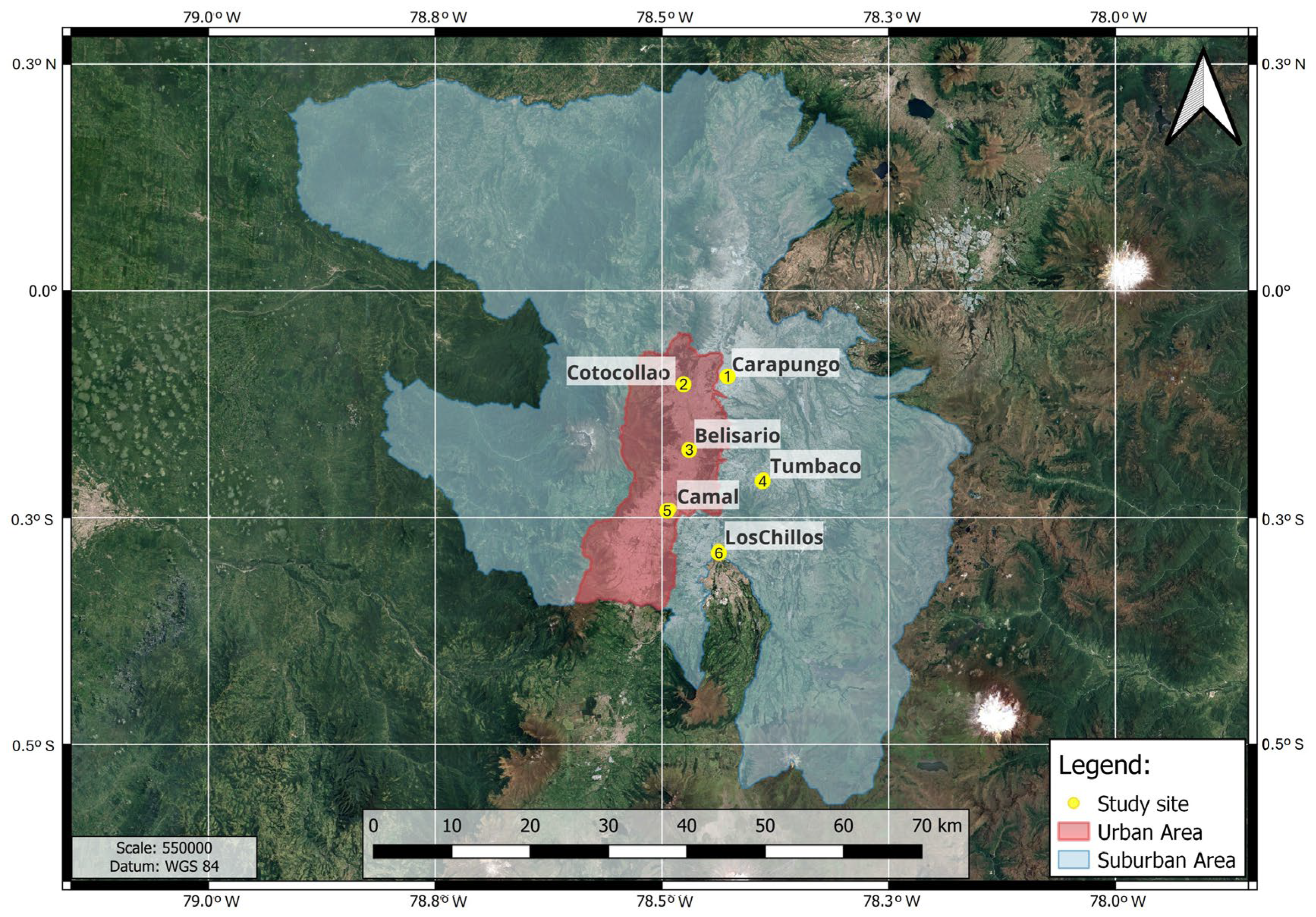
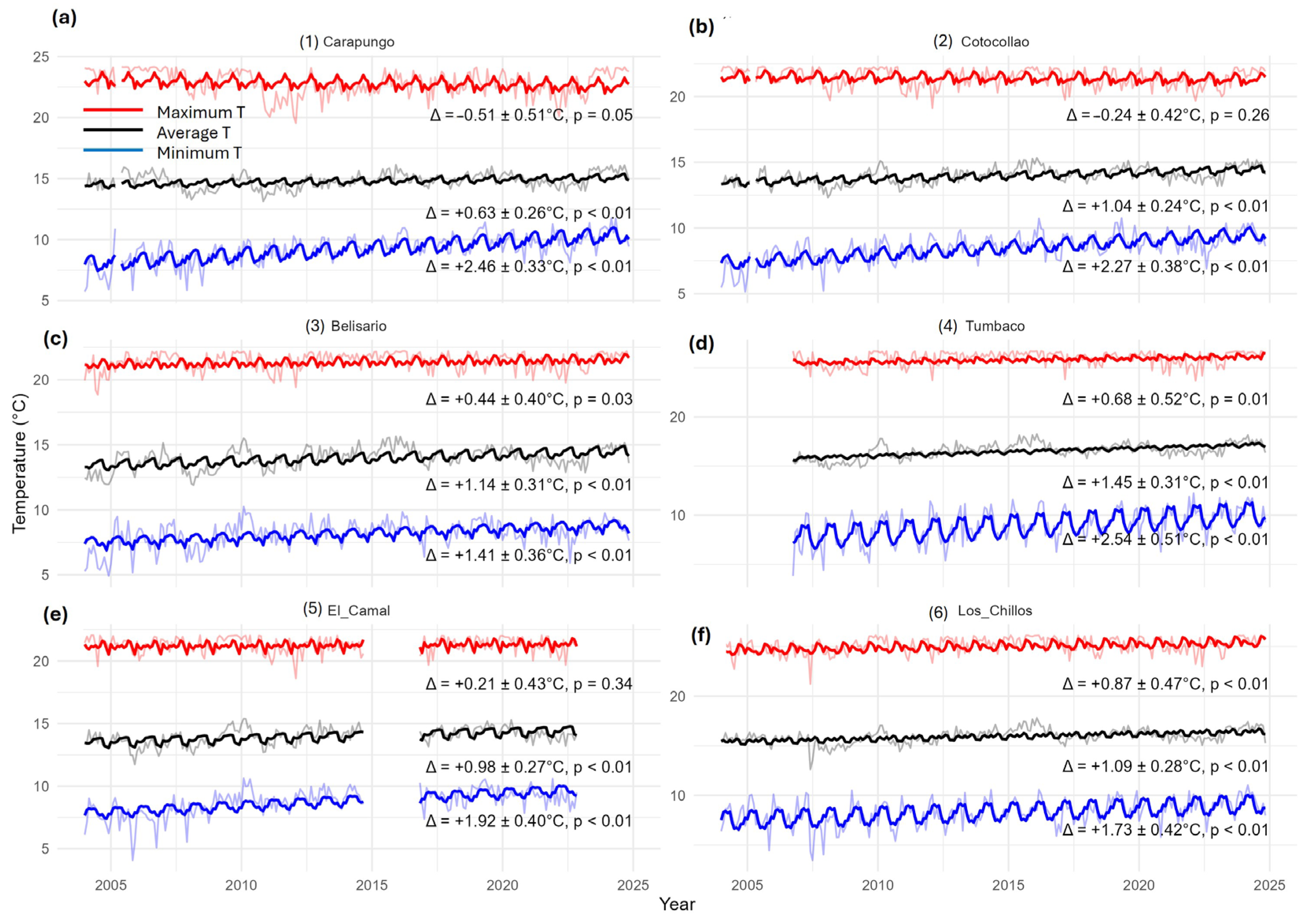
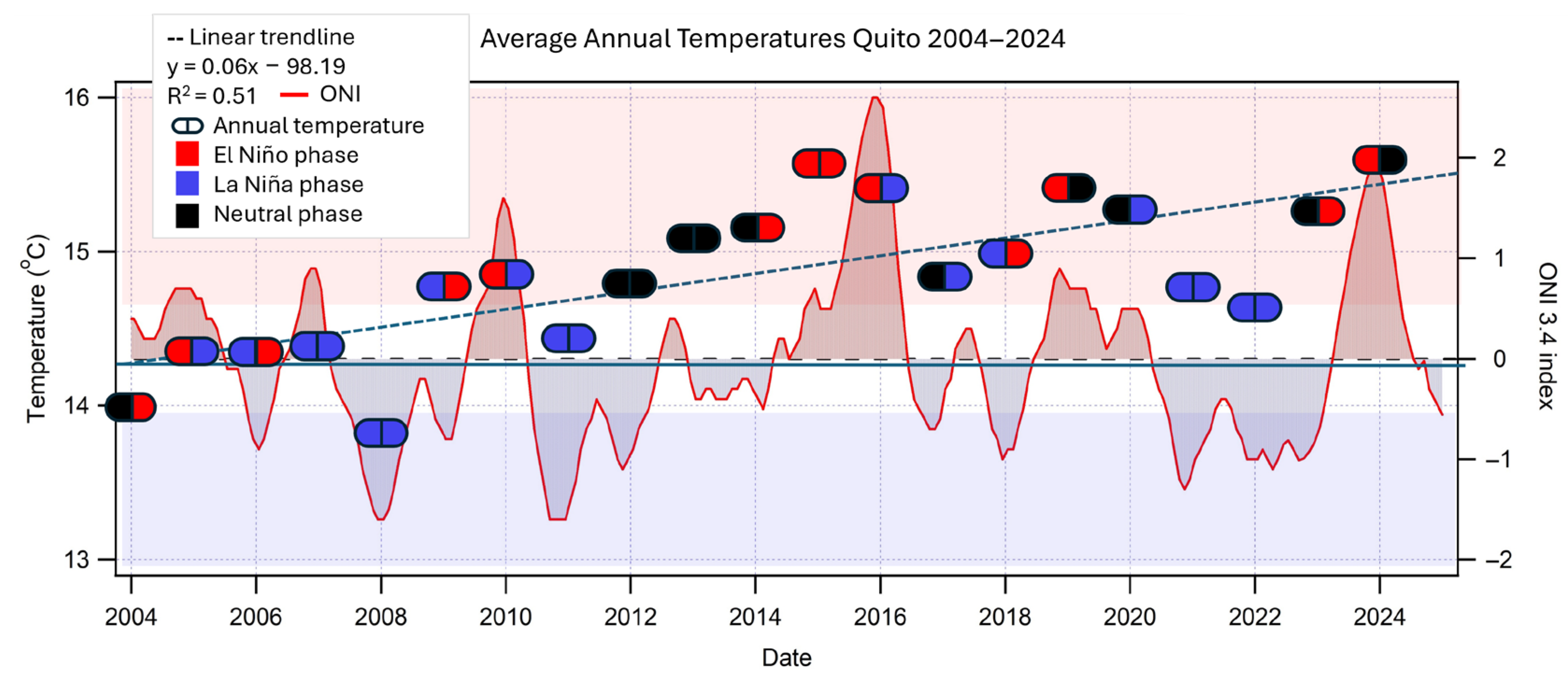
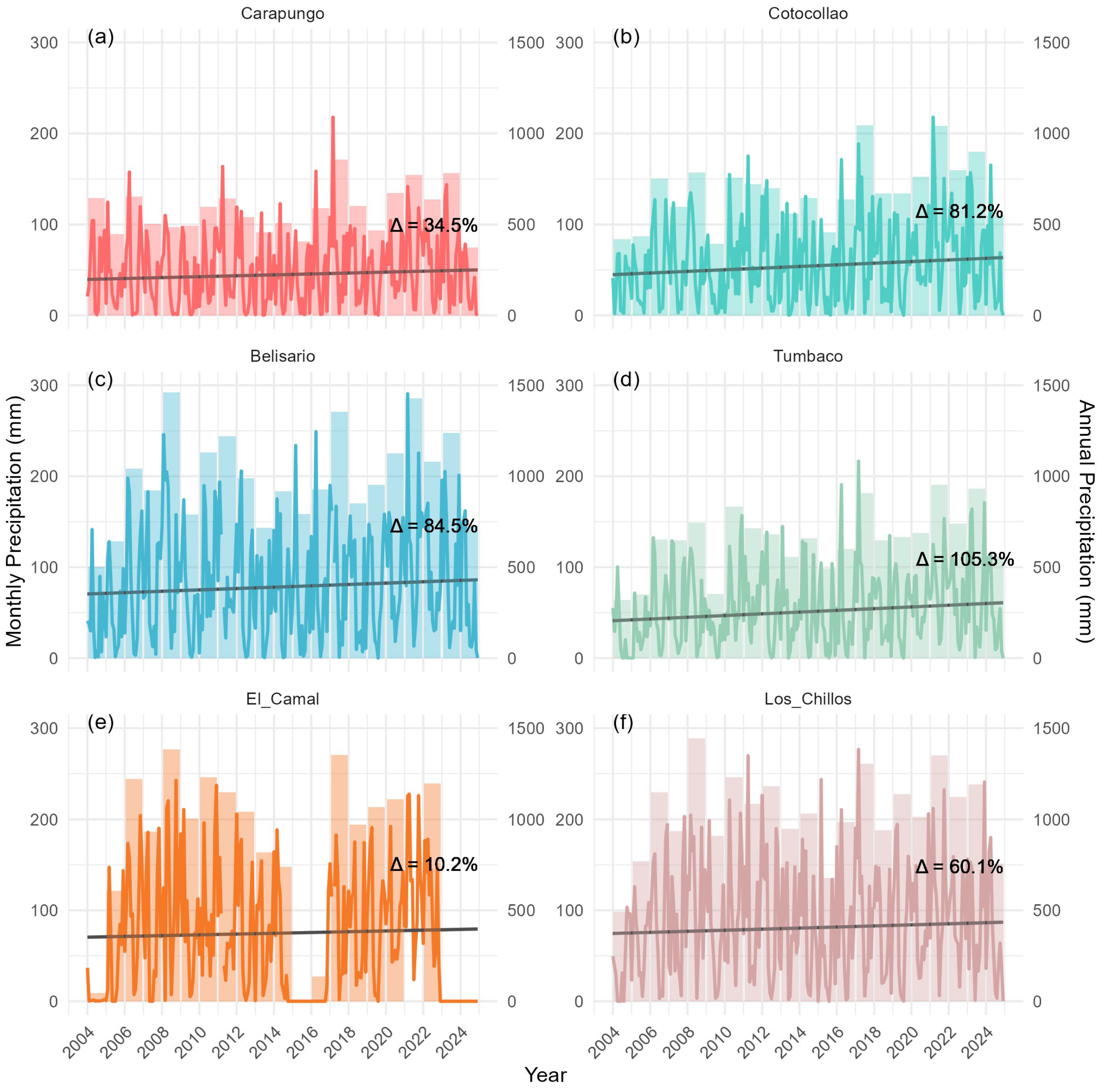
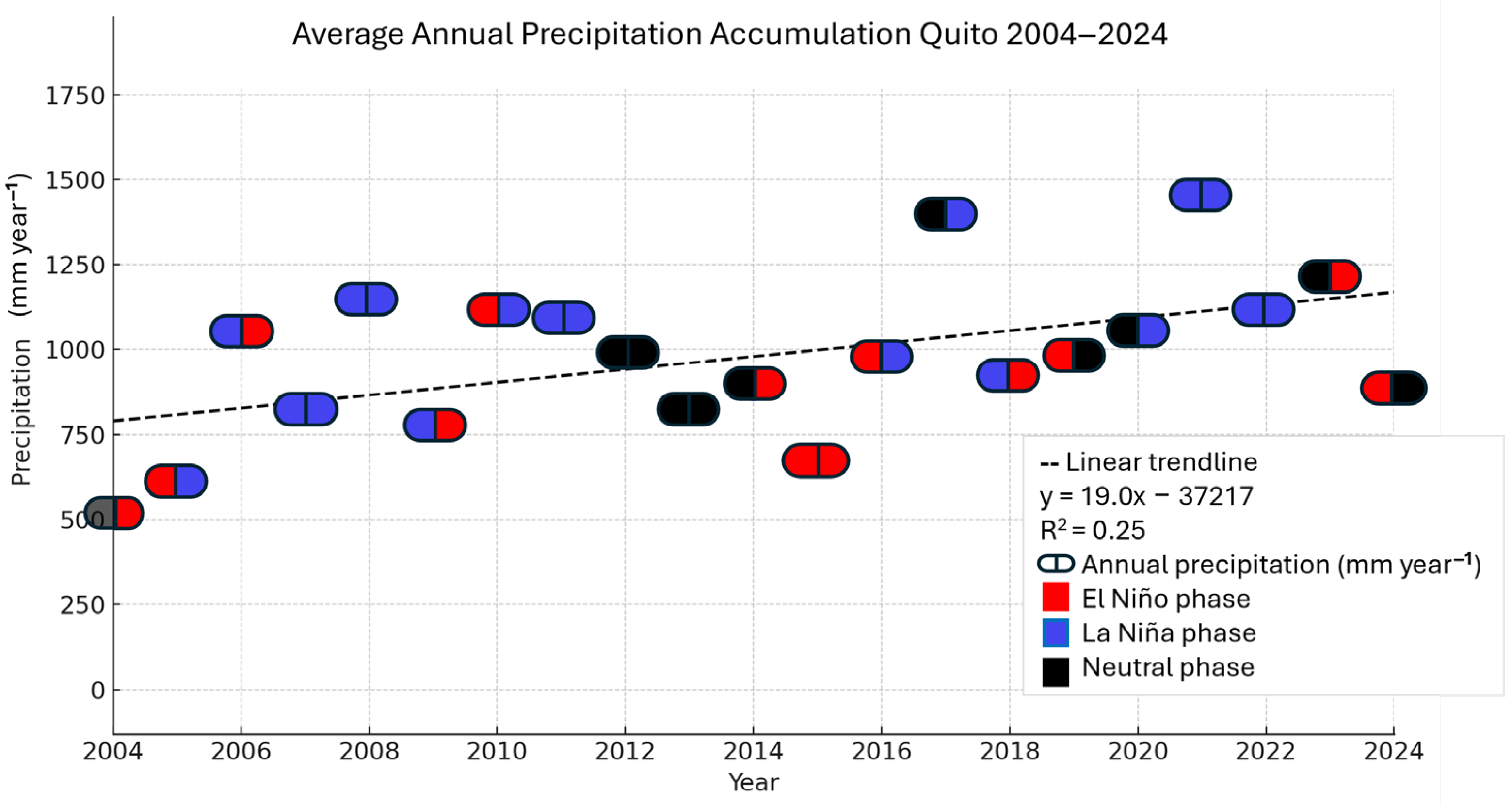
Disclaimer/Publisher’s Note: The statements, opinions and data contained in all publications are solely those of the individual author(s) and contributor(s) and not of MDPI and/or the editor(s). MDPI and/or the editor(s) disclaim responsibility for any injury to people or property resulting from any ideas, methods, instructions or products referred to in the content. |
© 2025 by the authors. Licensee MDPI, Basel, Switzerland. This article is an open access article distributed under the terms and conditions of the Creative Commons Attribution (CC BY) license (https://creativecommons.org/licenses/by/4.0/).
Share and Cite
Zalakeviciute, R.; Vallejo, F.; Erazo, B.; Chimborazo, O.; Bonilla-Bedoya, S.; Mejia, D.; Tapia-Flores, T.I.; Chuquimarca, G.; Rybarczyk, Y. Beyond Global Trends: Two Decades of Climate Data in the World’s Highest Equatorial City. Atmosphere 2025, 16, 1080. https://doi.org/10.3390/atmos16091080
Zalakeviciute R, Vallejo F, Erazo B, Chimborazo O, Bonilla-Bedoya S, Mejia D, Tapia-Flores TI, Chuquimarca G, Rybarczyk Y. Beyond Global Trends: Two Decades of Climate Data in the World’s Highest Equatorial City. Atmosphere. 2025; 16(9):1080. https://doi.org/10.3390/atmos16091080
Chicago/Turabian StyleZalakeviciute, Rasa, Fidel Vallejo, Bolívar Erazo, Oscar Chimborazo, Santiago Bonilla-Bedoya, Danilo Mejia, Tobias Isaac Tapia-Flores, Genesis Chuquimarca, and Yves Rybarczyk. 2025. "Beyond Global Trends: Two Decades of Climate Data in the World’s Highest Equatorial City" Atmosphere 16, no. 9: 1080. https://doi.org/10.3390/atmos16091080
APA StyleZalakeviciute, R., Vallejo, F., Erazo, B., Chimborazo, O., Bonilla-Bedoya, S., Mejia, D., Tapia-Flores, T. I., Chuquimarca, G., & Rybarczyk, Y. (2025). Beyond Global Trends: Two Decades of Climate Data in the World’s Highest Equatorial City. Atmosphere, 16(9), 1080. https://doi.org/10.3390/atmos16091080








